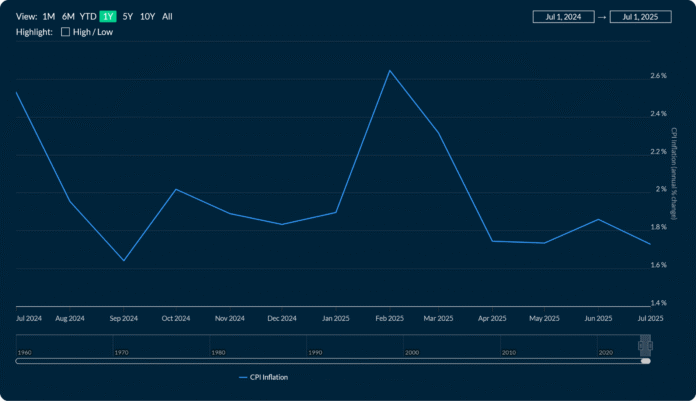Canada’s headline inflation rose 1.7% in July from a year earlier, down from June’s 1.9% increase, Statistics Canada reported Tuesday. On a monthly basis, the consumer price index was up 0.3%.
Core inflation eased to 2.6% from 2.7% the previous month.
More crucially, the Bank of Canada’s preferred inflation gauges—CPI-median and CPI-trim, which filter out volatile components—remained elevated. CPI-median edged up 0.1 percentage point to 3.1% in July, while CPI-trim held steady at 3.0% for a third straight month.
Bruno Valko of RMG Mortgages noted that CPI-trim “is at the upper band of the Bank of Canada’s comfort zone for inflation readings.”
BMO chief economist Douglas Porter noted that core inflation has shown “incredible stability,” rising by exactly 0.2% in each of the past three months. Still, he sees a silver lining.
“…that also means the three-month trend in each has eased to a reasonable 2.4% annualized pace,” he wrote. “That lines up with the MPR’s view that underlying inflation is close to 2.5%, with both the ex-food and energy CPI and the ex-gasoline CPI also landing at that mark in July.”
TD economist Andrew Hencic said a key takeaway from the data is a “softer trend in core inflation,” which he suggested points to price pressures running into headwinds from “economic slack.”
BoC unlikely to move on inflation alone, but wider conditions may force its hand
Although headline inflation has eased, economists say the data likely isn’t strong enough to push the Bank of Canada to cut rates on Sept. 17.
Scotiabank’s Derek Holt called the CPI release just one piece of a larger puzzle that also includes upcoming GDP, inflation and jobs data ahead of the next rate decision. “I’m sure we’ll get some market noise in the aftermath, but nothing about September’s BoC decision hangs in the balance on just this one reading,” he wrote.
“A lot more data lies ahead, including GDP … plus another jobs report, plus potential further developments in trade and fiscal policies among other factors,” he added.
Other economists, however, see the latest data as helping to set the stage for a cut as soon as September.
Hencic pointed to rising trade tensions, a weakening labour market and softer core inflation as factors that together support the case for a rate cut this fall. “All together this looks like the scenario the BoC highlighted as giving rise to the ‘need for a further reduction in the policy interest rate,’” he wrote.
And if August inflation data, which is due out before the next rate decision, show a similar trend, policymakers will likely be comfortable cutting interest rates by 25 basis points at the September meeting, according to CIBC economist Andrew Grantham.
Porter, for his part, said the Bank of Canada would need a “downside surprise” to trigger a rate cut, but added that if the recent core trend holds and the economy stays soft, it could “eventually set the stage for BoC cuts.”
Five-year bond yields dropped four basis points in response to the data, sitting at 2.96% soon after the release.
Visited 1,922 times, 712 visit(s) today
Andrew Hencic Bank of Canada brett Surbey Bruno Valko core inflation CPI-median CPI-trim derek holt douglas porter Editor’s pick rate cut forecasts
Last modified: August 19, 2025
